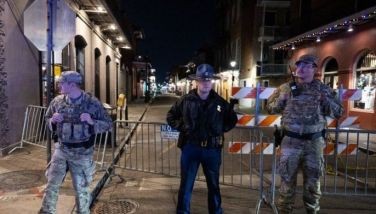Migrants find refuge 'north of the middle of nowhere'
HAMMERFEST - After hiding below the horizon for two long months, the sun has finally risen in Hammerfest, casting a pale pink hue over the Arctic landscape surrounding the world's northernmost refugee shelter.
From her modest room, Huda al-Haggar admires the wonderland of snow and ice, a sight so different from her native Yemen, where a Saudi airstrike destroyed her home, forcing her to flee with her young son.
"It's wonderful when I wake up in the morning and see this picture, the sea and the mountains. It's a wonderful place," the young woman says as 5-year-old Omar plays with Lego on her lap.
The wooden barracks where al-Haggar and her son live used to house oil workers until Europe's migrant crisis reached the jagged shores of northern Norway, where the continent drops dramatically into the Arctic Ocean.
Waiting for their asylum claims to be processed, hundreds of people in emergency shelters in Hammerfest and neighboring towns are slowly getting used to the extreme climate and unfamiliar customs of the High North.
They say they have adapted to the cold — the temperature rarely drops below minus 10 degrees C (14 F) along the coast, though it gets much colder further inland. It's the darkness that throws them off.
Rami Saad, a 23-year-old Syrian from Damascus with a neatly groomed beard and tight slacks, says workers at the Hammerfest center warned him about the polar night but he didn't believe them until late November, when "suddenly there was no sun."
The lack of daylight messed up his body clock, like the day when he rolled out of bed at 11 and ambled to the cafeteria to have lunch.
"But there was nobody there," Saad says, giggling. "It was 11 p.m."
Few of the asylum-seekers expected to end up here, 280 miles (460 kilometers) north of the Arctic Circle, when they left their homelands in the Middle East, Africa and Asia to escape violence, poverty, forced marriages or armies they didn't want to join.
Some were relocated by Norwegian authorities after entering the country from Sweden in the south. Others blazed a new trail into Western Europe by first entering Russia and then crossing its Arctic border with Norway.
More than 5,000 people, mostly Syrians and Afghans, used that route last year before the government tightened the border in November and started deporting those who were not deemed to be in need of protection in Norway.
Though that's just a trickle compared to the 1 million people who entered Europe last year from the south across the Mediterranean Sea, it forced Norwegian authorities to quickly set up migrant shelters in small towns separated by mile upon mile of untouched wilderness.
In Alta, a scenic two-hour drive to the south, the Northern Lights Hotel was converted into a shelter for unaccompanied minors. On Seiland island, a nature reserve west of Hammerfest, Stig Erland Hansen was asked to temporarily house dozens of asylum-seekers in a remote lodge where he hosts adventure tourists during the summer.
"At first I thought it was crazy," Hansen says, clasping a cup of black coffee inside the main cabin. "Is it possible to have people in darkness on an island?"
Not only was it possible, it was a big success, according to Hansen and Paal Mannsverk, who manages the camp, a cluster of wooden houses facing a pristine fjord. Reachable only by boat, the isolated location gives you a sense of being at the end of the world — or as Mannsverk put it: "north of the middle of nowhere."
Yet the 36 asylum-seekers staying here, all but one from Afghanistan, seem surprisingly at ease. Hansen and Mannsverk say it's because they try to keep them active: fishing, chopping wood, sledding, skiing, and hiking instead of just sitting around waiting for a decision by the Norwegian Immigration Directorate, which can take more than a year.
The camp on Seiland is a far cry from the crowded and jail-like migrant centers in some parts of Europe. Afghan children laugh and holler as they sled down the slope from the camp to the rocky shoreline, where men speaking Dari rinse fish caught in the icy fjord.
Later, as the sun drops behind the mountains, they will cook them over an open fire with onion, tomatoes, eggs and spices brought in from the mainland.
To some the contrast with the life they left behind is almost surreal.
"I was in Afghanistan, a country far away from here and now I'm in the north of Norway. I could never have imagined this," says 20-year-old Zakria Sedequi.
He says he fled Afghanistan's Maidan Wardak province after the Taliban tried to recruit him. An ugly scar over his left eyebrow suggests they didn't ask nicely. Sedequi says they rammed the butt of a Kalashnikov rifle into his forehead. He documented the bloody mess with his cellphone camera.
Inside the camp, 62-year-old Shukria Nawabi tears up as she recalls the hardship her family faced in Kabul. She has lived on Seiland since October with her husband, daughter and grand-daughter Helenar, a 7-year-old with pigtails, pink tights and a sheepish smile.
"We escaped from enemies in our life," Nawabi says through an interpreter, declining to delve into the details.
Wrapped in a shawl, her daughter, Sufya, seems almost offended when asked whether the family struggled to adjust to the darkness on this desolate island.
"If you were in my place," she says, "where bombs are going off in the street, where women are treated badly, and you come to this place, would you worry about the darkness and the isolation?"
A handful of young men who were transferred to Seiland didn't see it that way. They decided this wasn't the place for them, packed up their belongings and asked to be taken ashore. Some went back to Russia, where they had been studying. A couple traveled all the way to Italy, says Mannsverk.
By the spring, the lodge will go back to its regular tourist business and the asylum-seekers will have to be transferred elsewhere, perhaps to permanent asylum centers like the one in Alta. The city of 20,000 has years of experience with integrating asylum-seekers into the local community.
The staff at the Hero asylum center in Alta try to prepare the newcomers for life in Norway by teaching them local customs, including how to treat women, a subject given particular attention after reports of mass sex assaults blamed on migrants in Germany on New Year's eve.
"Norwegian women can drink alcohol and be loud just like men. This is completely normal in Norwegian society," says Ingunn Soergaard, a petite woman with waist-length hair and a crystal-white smile.
Her audience of 18 asylum-seekers, mostly from Syria, look at her with bewilderment. Not because they think it's weird that Norwegian women drink, but that Soergaard thinks they don't know that.
"We've seen that on TV. And we know that's how it is here. It's not an issue," says Anod al-Ali, a 31-year-old teacher from Syria.
Soergaard's co-presenter, Goeran Johansen, decides to push the issue further.
"Let's say I'm meeting Ingunn for the first time and she invites me home to have sex," Johansen says. "And then suddenly at home she says, 'No, I don't want to have sex.' What do you do?"
Some of the students shift awkwardly in their seats. Walaa Aziri, a 23-year-old Palestinian woman with a hijab turns bright red and hides her face in her hands.
Finally, Ahmed Dawwas, a 36-year-old engineer who fled the Syrian city of Raqqa, an Islamic State stronghold, breaks the silence by turning the question around.
"What if she invites me and I say no? How should she react?" Dawwas asks.
When the laughter dies down, he strikes a more serious tone.
"We have come here to live in peace," he says. "We have fled war. We're not here to go after women. I don't understand why this has to be explained to all Syrians."
- Latest
- Trending



























